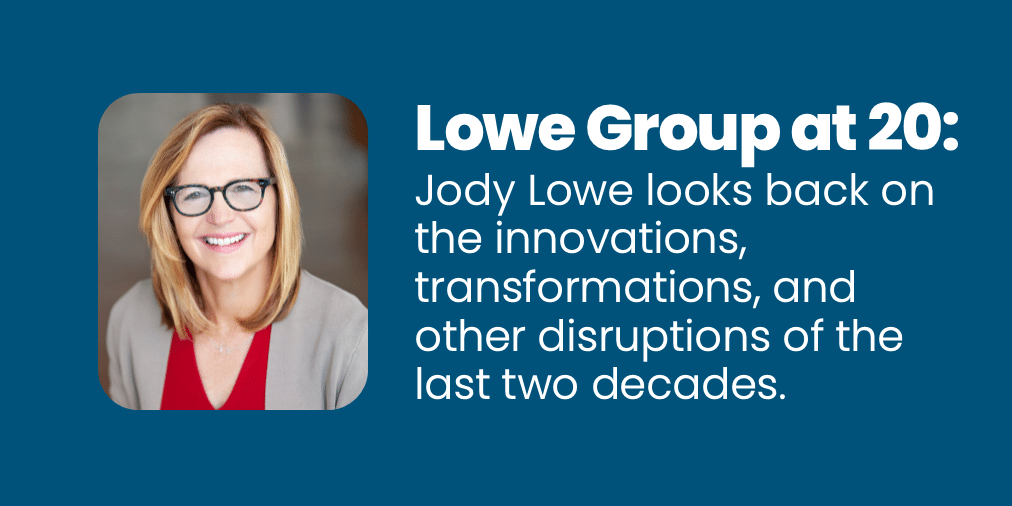
The only constant is change: Lowe Group celebrates 20 years of investment communications
Twenty years is a long time. Headlines in 2003 included the human genome project, the space shuttle Columbia tragedy and the capture of Sadam Hussein in Iraq. Feels like another world. Lowe Group’s humble beginning 20 years ago providing traditional public relations services to a handful of asset managers seeking media attention feels like another world.
In the beginning, we talked to traditional media like the Wall Street Journal and New York Times and industry trades like InvestmentNews and Financial Planning whose readers mainly read their stories in print. TV interviews were on CNBC or Bloomberg (Fox Business wasn’t launched until 2007), but you had to show up in-studio or at a local TV news affiliate for a satellite connection.
So much has changed over the last 20 years. An anniversary like this gives us a chance to document this amazing evolution. Here’s what stands out.
Digital transformation — When we first started pitching our clients to media, we’d be disappointed when their stories were posted “only” to nascent media websites. And social media was yet to even be part of the PR equation with LinkedIn launched in 2002, Facebook in 2004 and Twitter in 2006. Since then, the digital revolution has meant that clients can reach a global audience online instantly. While audiences are more fragmented, which can be difficult on the advertising side, there are many more opportunities to create visibility. And as my colleague and head of LG Digital Pat Allen regularly reminds me, everything is now so much more measurable.
Rise of the RIA — Many of our favorite media sites like CityWire RIA and RIA Biz didn’t even exist as the bulk of advisors were at wirehouses and traditional brokerage firms. But the shift to fiduciary advice saw advisors move to fee-based models and an explosion in the number of CFPs. This was helped by consumer demand due to the march of demographics as the first Baby Boomers began to retire in 2011.
A changing mutual fund product landscape — Exchange-traded funds, the first of which (SPDR) was launched just 30 years ago, ushered in a new way to invest and grabbed market share from traditional mutual funds. While mutual funds with good track records, well defined processes, unique or alternative investment approaches and reasonable costs can still build a following, they face steep competition as more and more advisors adopt ETFs. More recently, advisors and some consumers are gravitating toward separately managed accounts (SMAs) and direct indexing; technology now allows asset managers to customize these accounts for tax and other purposes.
Sustainable investing goes mainstream — Twenty years ago, sustainable investing was small and niche. A maturing of the industry and consumer interest, driven by a warming climate and seemingly intractable societal issues has meant more investment products use environmental, social and governance criteria. Despite a recent backlash, research shows many investment managers consider ESG factors material to their investment process.
The rise of the brand as publisher —Web 2.0 (Tim O’Reilly’s seminal explanation appeared in 2005) and the mainstreaming of blogging and podcasting capability had at least two direct effects on this business:
- Firms began to communicate more and directly to their clients and investors as opposed to waiting to be interviewed by traditional media.
- The stream of firm thought leadership and market content equipped us with more to reach out to engage media.
The rise of owned media — This rapid increase in content became the crux of much of our communications outreach efforts. It provides our clients with the opportunity to demonstrate their authority through their blogs, whitepapers, educational webinars and decks—all “owned” media our clients create and control that often gets placed into publications, becoming “earned” media.
The impact of social media — Easy to publish websites and blogs and the use of social media to call attention to them gave rise to new voices, representing neither known brands or traditional media. In our industry, Michael Kitces may be the best illustration of a force known as an influencer. Today influencers are part of any awareness-raising campaign.
Social amplification — The explosion of social media meant that organizations can engage immediately and around the clock with customers, prospects, policy makers and media. This is a two-edged sword, especially in a crisis, when rapid fire interactions and memes can leave companies struggling to respond (see Making a statement at a time of global conflict: Many asset managers say ‘No, thanks’).
 The slow rise of female and diverse managers – The last 20 years has not seen women and people of color widely represented in senior positions at fund companies or RIAs/advisory firms which remain disproportionately white and male.
The slow rise of female and diverse managers – The last 20 years has not seen women and people of color widely represented in senior positions at fund companies or RIAs/advisory firms which remain disproportionately white and male.
Yet news organizations like CNBC and others have shown heightened interest in featuring more women and diverse voices, and smart media pros recognize that the dearth of diverse experts creates an opportunity for women and people of color.
So much has changed over 20 years. We’re grateful to work in an industry that is interesting and ever changing. We are also grateful to have worked with so many great clients. To celebrate 20 years, we are hosting an open house at our Milwaukee office on November 30 where we will raise a toast for the next 20 years. Please email us if you can join us.
Subscribe.
Receive the latest news and insights from Lowe Group.
